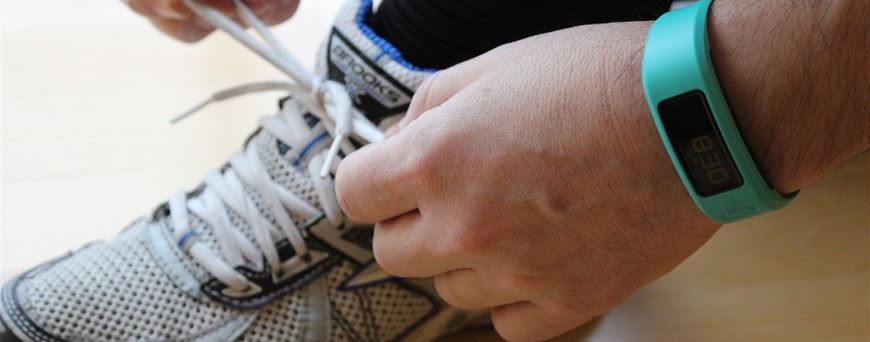The Garmin Vivofit is a fitness band which sets you a daily, personalised activity goal, prompts you to exercise and tracks your results. It's designed to be worn around your wrist and can be worn day and night, even in the shower. You can track your progress and join in with online challenges via a free app on your mobile phone or computer.
The device comes with two bands of different sizes: small and large. At first it was tricky to fasten the band around my wrist but I soon managed it.
I have quite a small frame - I'm 5'2" tall - and I think that the Vivofit looks quite chunky on my wrist, but it's very light (it weighs 25.5g) and comfortable to wear.
I tested the Vivofit over the course of a few days during which time my activity consisted of walking the dog, looking after my children and working hard whilst sitting at my desk.
The Vivofit comes in five strong colours: black, teal, purple, blue and grey. My Vivofit is teal and while I don't dislike the colours available, I would prefer something more subtle, especially as it's meant to be worn all of the time. Something like the navy blue colour option of the Jawbone fitness band works better for when you're not wearing sports gear, I think. As the bands are interchangeable it would be great if Garmin could offer a wider range of colours.
The Vivofit is supplied in a box with a couple of sheets of paper with simple graphics. One shows how to swap the wrist bands and the other has an image of the Vivofit with large arrows pointing towards a phone and a laptop with the words 'Setup required'. I'd prefer to have had more detailed instructions to follow in order to set it up but I managed to work out what to do.
You need to 'pair' the device with your phone or computer and download the free Garmin Connect app before you start to use it. On the app you enter personal information such as your age, height and weight so that it can set you targeted, daily goals.
There's a single button next to the Vivofit display screen and if you press this you can see a range of different information: the number of steps you've taken today, your personalised goal for today, the distance you've covered today, the calories you've burned, the time, the date and your heart rate - although this only works if you have the accompanying Garmin heart rate monitor.
If you press and hold this button you can synchronise the Vivofit with your linked mobile phone or computer in order to upload the data about your activity. I was intrigued to see how far I walk at various times of the day - it appears that I walk about 0.6 miles every morning just between waking up and leaving the house to take the kids to school.
Once you've uploaded the data you can go on to the Garmin Connect app to see your progress for the day, week, month and year in the form of bar charts and written data. You can also see how much sleep you've had.
Interestingly, you can also connect with other Vivofit users and get involved with challenges through the app.
Garmin is best known for its GPS devices but the Vivofit has no GPS capability. The display is not backlit which means that (obviously) you can't see it in the dark which, for me, limits its use as a wristwatch replacement. However, a big selling point is that It has a battery life of one year which means that you don't have to worry about recharging or changing the batteries very often, in contrast to some other models on the market. For example the Fitbit Flex battery lasts for only about five days when fully charged.
The Garmin Vivofit recommended retail price is £99.99 but it's always worth shopping around for the best deal - see the links below. It's competitively priced in comparison to other fitness bands such as the Fitbit Flex with a RRP of £79.99 or the Jawbone UP24 at £99.99.
For me the best aspects of the Garmin Vivofit are the personalised daily goals and the red warning bar which appears when you've been sitting still for too long. I spend much of my time sitting and writing and so these features are just what I need in order to prompt me to stand up and move around every so often, and to take the dog for a walk to make sure that I meet my daily goals.
The step count increased slightly when I was driving and I assume that this is because my wrist was moving, but this is common with activity trackers. I checked the step count when I was walking and found it to be accurate to with two or three steps, which was actually much better than I'd expected.
I hadn't used a device like this before and I wasn't sure whether or not I'd like it. My twelve year-old son took to it straight away - when it first arrived he decided to use it to measure our house in steps and he's been asking if he can wear it as his watch. My husband enjoys running and he's also keen to try it out.
I'm not letting either of them get their hands on it though - I'm a convert and am going to carry on using it myself.
Pros
The long battery life, personalised targets and prompts to move about.
Cons
No backlight, strong colours.
Recommended Use
For anyone who wants to track and improve their activity and fitness levels.












